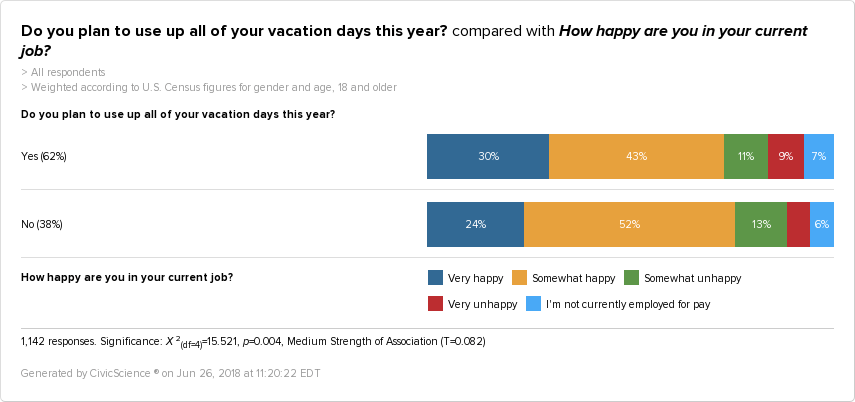The Gist: US adults love their vacations. However, intent to vacation reveals some disparity among income levels and genders.
Ah, summer. Every year around this time, the pace of life seems to slow down, the days get longer, and work takes a backseat to long-awaited vacation time.
Or does it?
We’ve been curious about what the state of vacation actually looks like these days. Who’s taking it and how are they spending their time? So we thought we’d take a look and see.
First, let’s be clear: vacation is very much a priority.
In fact, 78% of US adults plan on using some of their vacation days this summer. As for the roughly ⅕ of US adults who will not be, it’s possible that they prefer to vacation in other months, or not at all.
So, let’s talk about our vacation-takers. As it turns out, 62% intend to use all of their vacation days this year, so don’t be surprised when the familiar ‘out of office’ emails begin to roll in.
But, could that vacation day-taking be a privilege? The data indicates this could be the case.
While US adults across all income levels are almost equally as likely to take a vacation this summer, those who are not going on summer vacation are largely from the under $50k crowd. As we can see, just over half of US adults not taking a summer vacation make less than $50,000 a year. So clearly, money plays some sort of role, but what exactly could it be?
Let’s take a look at specific vacation activities to find out more.
Traditional vacations–ones where you leave your home and go on a trip–are still the most common, as 35% of our respondents say they will be using their vacation days to go out of town.
However, having a staycation or getting things done around the house are also popular choices when using those prized days off, coming in at 27% and 26%, respectively. Especially if money is playing a factor, vacation days without the burden of expensive travel tickets, hotel stays or meals out can feel more luxurious.
Regardless of the activity taking place, Gen X-ers are the majority of those who say they will be using all of their vacation days. This could make sense, given the fact that these individuals are likely to have more time accumulated off or money saved than Millennials–the next largest group in our data set.
However, parental status does not seem to play a role, with parents and non-parents tied in their vacation intent. This could indicate that vacations these days are not just for families, but for adults in all life-stages, just looking to get away from the daily grind.
Upon closer look, it seems that escaping work may not be the strongest motivation for using that vacation time. Below, we can see that people who are very happy in their job are actually more likely to take all of their vacation days. This echoes the trend we saw in after work activities, where the happier employees were more likely to go out than their unhappy counterparts. It would seem, then, that a good work environment begets happier and perhaps even more well-rounded workers, the kind who have evening plans and take their hard-earned vacation days seriously.
But, of course, there is one elephant in the room we haven’t yet explored: gender. And, as is often the case, there is, in fact, a gender divide, even when it comes to vacation.
While 56% of those planning to use all of their vacation days are men, only 44% are women. On the surface, it may not seem like the biggest leap. However, it does raise some questions regarding workplace culture. If all things were equal, shouldn’t men and women be taking equal advantage of the vacation days they’ve accumulated? What could be dissuading women from making the most of their time off? This is a question the data can’t answer.
Ultimately, vacation does not seem to be losing popularity any time soon. Even in our work-focused culture, the majority of US adults plan on taking a vacation this summer. However, vacationing–even the staycation kind–could be a privilege, as we see low-income earners and women taking fewer days off.


















